- Home
- >
- Set builder notation – Explanation and Examples
JUMP TO TOPIC
Set Builder Notation – Explanation and Examples
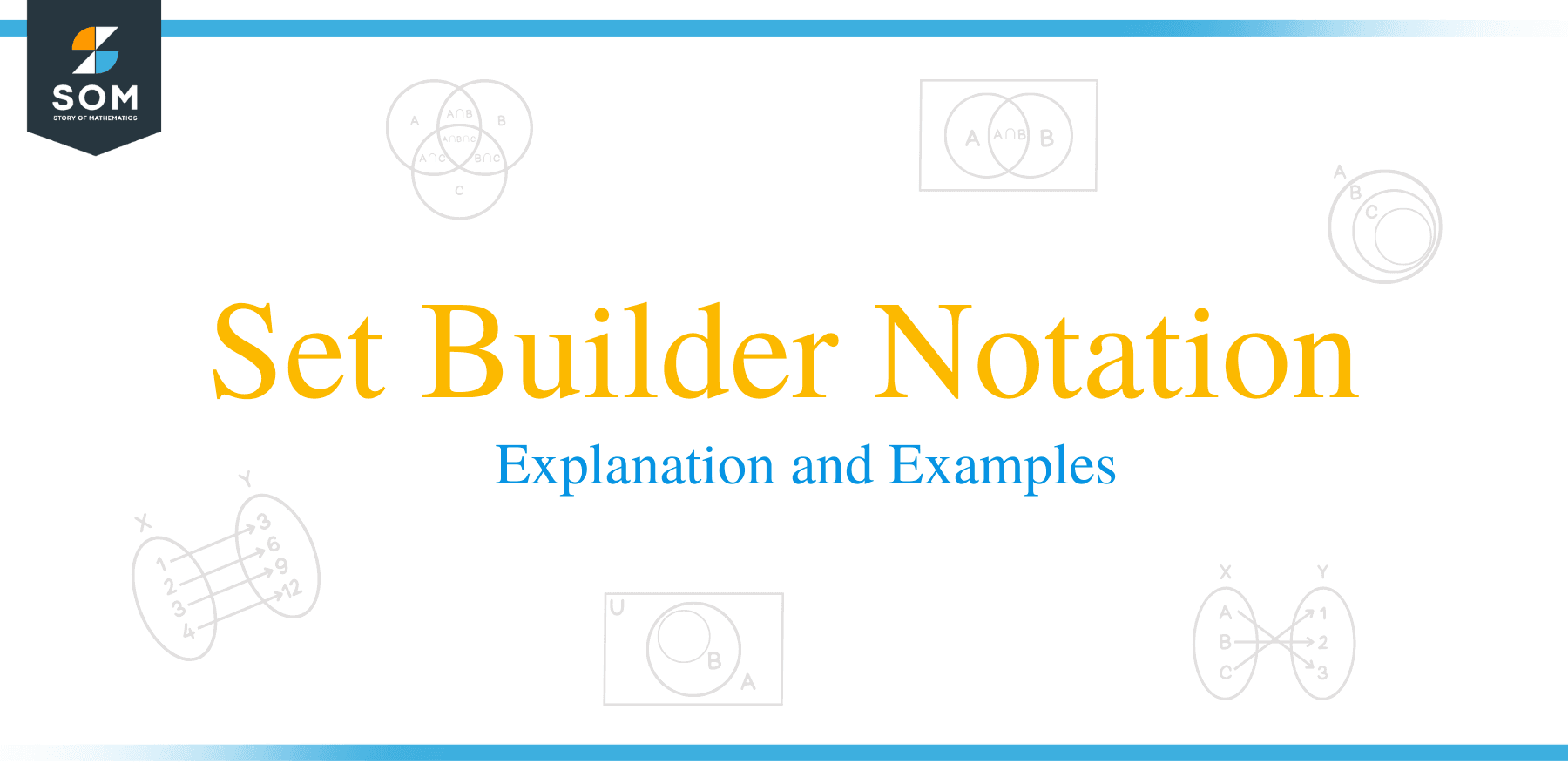 The language of mathematics and logic is much more convenient and universal than any other language. Mathematicians prefer to write and explain in the form of symbols that is understandable. The same case applies to sets as well. We have already covered everything concerning sets. We discussed the set types, set operations, set properties, and set laws. Now let’s move onto the final topic that is the Set Builder Notation.
The language of mathematics and logic is much more convenient and universal than any other language. Mathematicians prefer to write and explain in the form of symbols that is understandable. The same case applies to sets as well. We have already covered everything concerning sets. We discussed the set types, set operations, set properties, and set laws. Now let’s move onto the final topic that is the Set Builder Notation.
Set theory is the branch of mathematics that provides three different notations for defining and describing the sets, including tabular form, set builder notation, and descriptive form.
In this article, we are going to discuss the set-builder notation. It basically corresponds to outlining and describing sets in the form of symbols.
We will be covering the following topics in this article:
- What is set builder notation?
- What is the Roster method?
- Why is the Roster method not efficient?
- How to use set builder notation?
- How to write set builder notation?
- How to read set builder notation?
- Interval notation.
- How to write in interval notation?
- Examples
- Practice Problems
Before moving forward, you may consider refreshing your knowledge on the following prerequisites:
What is Set Builder Notation?
The question that young mathematics enthusiasts frequently ask regarding sets is that what is the set builder notation? So let’s first address that question.
Set builder notation is defined as a mathematical notation used to describe a set using symbols. It is used to explain elements of sets, relationships, and operations among the sets. A collection of numbers, elements that are unique can be described as a set.
Let’s take an example. Consider the set A, which is given as:
A = {2,4,6,8,10}
The above set A can be written in set builder notation as follow:
A = {2x | x € N }
We say, “set of all x’s containing even natural numbers.” We can also say that set A contains positive multiples of two.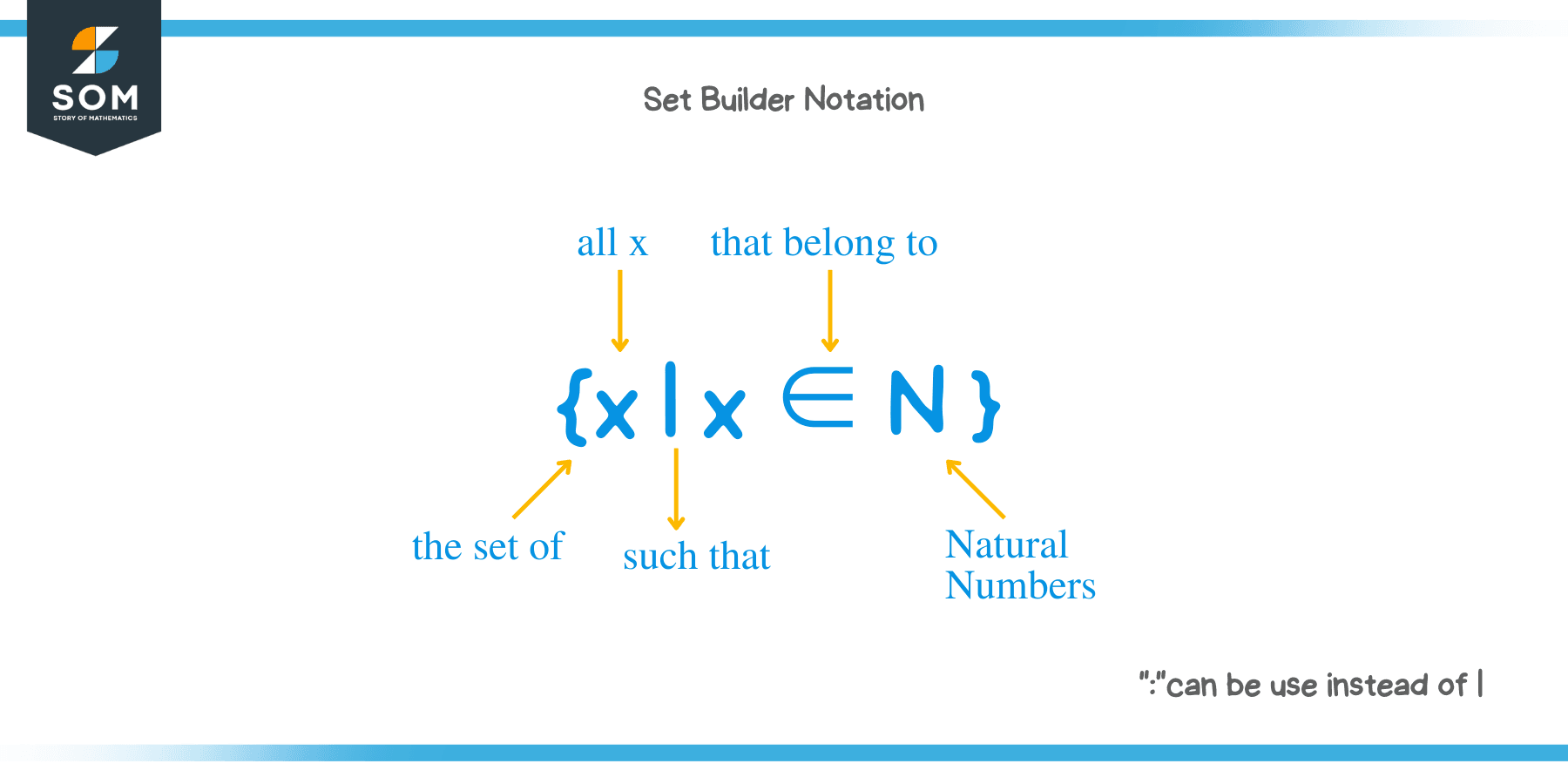
What is the Roster Method?
The Roster Method is a term that often confuses mathematics students. It is one of the methods for notifying sets.
According to this method, a set can be defined directly by counting all of its elements and mentioning them between the curly brackets, as shown in the following examples.
A = { 1,2,3,4,5 }
B = { 1,3,5,7,9 }
This method of defining sets is also called a Roster Method.
Why is Roster Method not Efficient?
The Roster Method makes set notation a straightforward concept to comprehend. But this method lacks universality and accuracy as all sets can not be defined using this method as enumeration can be too long or difficult to be explained. So the Roster method is not efficient. Therefore, some sets require to be defined by the properties that illustrate and describe their elements.
Consequently, the concept of set-builder notation was introduced that indicates and explains the properties of sets in a much more specific way and often uses a predicate characterizing the elements of the set that is being defined.
You might be wondering why we need such a complicated notation when we can use the roster notation to describe the sets that are probably much easier to express and understand. For example, if we want to write the set of an integer between 5 and 8, we could write it using roster notation as follows:
A = {5, 6, 7, 8}
Whereas, writing the set A in a set builder notation is as follows:
A = { x € z | 5 < x < 8 }
But the problem arises when we have to list elements lying inside either the small intervals or a very large set of numbers, or even an infinite set. Using roster notation does not make sense and is a very tedious method. Therefore, we use set-builder notation for such conditions.
How to use a Set Builder Notation?
Set builder notation is a mathematical notation that describes a set by stating all the properties that the elements in the set must satisfy. It is specifically helpful in explaining the sets containing an infinite number of elements.
Set builder notation has three main components:
- A variable is usually written in the lowercase
- Vertical bar separator or colon which is read as “such that”
- Logical sentence which states the properties of sets
The above mentioned three components of set builder notation are written inside the curly brackets as shown below:
A = { variable | notation }
Or
A = { variable : notation }
A = { x | x θ(x) }
Or
A = { x : θ(x) }
The vertical bar is a separator that is read as “such that” or colon “:”. θ(x) corresponds to the predicate (logical statement stating the properties which set holds), for all the values of x for which the predicate is true belongs to the set that is being defined.
A domain can also be defined on the left side of the vertical separator, such as
A = { x € S | θ(x) }
It can also be represented using “and” logical operator, also known as “logical conjunction.”
A = { x | x € S ˄ θ(x) }
Where € shows the set membership, ˄ is the logical “and” operator. This notation indicates that all the values of x that belong to some given domain S for which the predicate is true.
Let’s consider an example for better understanding.
Example 1
Express the following sets in a set builder notation.
- The set of integers less than 5.
- {-6,-5,-4,-3,-2,…}
- The set of all the even numbers.
- The set all the odd numbers.
- The set of numbers greater than or equal to 2.
Solution
- The set builder notation is given as
A = { x | x =5n, n is an integer }
- The set builder notation is given as
A = { x | x > -7, x is an integer }
3.The set builder notation is given as
A = { x | x = 2n, n is an integer }
4.The set builder notation is given as
A = { x | x = 2n + 1, n is an integer }
5.The set builder notation is given as
A = { x | x ≥ -2 }
How to write a Set Builder Notation?
Now that we know what Set builder notation is let’s move on to the next concept: write the set-builder notation.
Follow the steps given below to write the sets in set builder notation:
- Describe the elements of a set using a lowercase letter such as x or any other letter.
- Use the symbol colon ( : ) or vertical bar ( | ) as separator.
- After the symbol, state the condition of the property that all the given set hold elements.
- Write the complete description inside the curly brackets { }.
Let us discuss the two different types of representation with the help of examples for a better understanding.
Statement | Tabular form / Roster Form | Set Builder Notation |
The set of all the even numbers between 1 and 19 | { 2 , 4 , 6 , 8 , 10 , 12 , 14 , 16 , 18 }
| { x | x = 2n n is integer 1 < n < 9 } |
The set of natural numbers between 5 and 10. | { 6 , 7 , 8 , 9 } | { x | x € N 5 < x < 10 } |
The set of all four seasons. | { spring, summer, winter, autumn } | { x | x is the name of four seasons } |
Now we will specify the type of numbers or domains which we use with the set builder notations. Consider the following example where set A is given as:
A = { x € R x<4 }
Where € stands for “member of.” R is the symbol that corresponds to “real numbers.” So, set A contains the value of x in R such that x is any number less than 4.
So, there are other types of numbers as well besides the real numbers. We will discuss some common domains that are used widely in mathematics.
Natural numbers:
Natural numbers are non-negative numbers. They are denoted by N.
So, the set of natural numbers can be defined as
N = { 1,2,3,4,5,…}
Real Numbers:
All the numbers, including positive, negative, natural, whole, decimal, rational, irrational numbers, and all the integers, are included in real numbers. The symbol R denotes it.
So, all the numbers except for imaginary numbers are included in the category of real numbers. Some examples are given below:
R = { 1,2,3,4,5,…}
R = { 0.1,0.2,0.3,…}
R = { 1/3 ,1/5,1/7,…}
Whole Numbers:
Whole numbers start with zero and include all the natural numbers.
So, the set of the whole number is given as
W = { 0,1,2,3,4,5,…}
Rational Numbers:
Rational numbers are expressed in the form of fractions, i.e., p/q. They are denoted by symbol Q.
An example of the set of rational numbers is given as:
Q = { 1.8, 1.9, 2 }
Integers:
Integers are the set of positive numbers, negative numbers, and zeros. Integers are denoted by symbol z.
An example of the set of integers is given below:
Z = {0,+1,-1,+2,-2,…}
Imaginary Numbers:
An imaginary number is a number that gives a negative result when squared. The imaginary number is called iota i, which is equivalent to √-1.
Imaginary numbers are defined as the proportion of complex numbers. They are denoted as c. An example is given below:
C = { 2+3i, 2+4i, 2+5i }
The important thing to note in all these various set types is that all the sets are infinite, and the set-builder notation is used to describe these sets.
Let’s look at some examples for a better understanding.
Now, let us discuss some examples regarding set builder notation using predicates and domains to understand better.
Example 2
Write down the set-builder notation for the given sets
- Set of positive real numbers.
- Set of all rational numbers.
- The set of odd natural numbers.
Solution
- The set builder notation for the descriptive set is given as
A = { 2n | n € N }
2.The set builder notation is given as
A = { p / q | p , q € z, q ≠ 0 }
3.The set builder notation is given as
A = { 2n + 1 | n € z }
Example 3
Represent the following in set builder notation
- Y = { January, February, March,…, December }
- Z = { Monday, Tuesday, Wednesday,…,Sunday }
Solution
1.The set contains the month of the year. Therefore, the set builder notation is given as
Y = { x | x is months of the year }
2.The set contains the days of the week. Set builder notation is given as
Z = { x | x is days of the week }
Example 4
Graph the interval and then express using set-builder notation.
Interval: (∞ , 5]
Solution
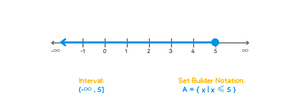
Therefore, the set builder notation is given as
A = { x | x ≤ 5 }
The set contains all the numbers equal to or less than 5.
How to read Set Builder Notation?
Set builder notation is a method of specifying set properties that are true for all the elements confined in the set. Set builder notation is written in the form
A = { x | condition about x }
is read as “ the set of all the values of x such that the given condition about x is true for all the values of x.”
The colon can be replaced by a vertical bar but is read in the same manner.
A = { x : condition about x }
Both the colon and the vertical bar signify the same words “ such that” in the set-builder notation description.
Consider the following example to have a better understanding of the concept. The set builder notation is given as:
A = { x | x is a natural number, x>7 }
which is read as :
“ A is the set containing values of x such the x is a natural number greater than 7 .”
Let’s look at some more examples.
Examples | Set Builder Notation | How to read? |
A = { x | x is set of real numbers } | Set A contains all the values of x such that x is a real number. | |
2. | B = { x | x > 0 } | Set B contains all the values of x such that x is greater than 0. |
3. | C = { x | x ≠ 20 } | Set C contains all the values of x such that x is not equal to 20. |
4. | D = { x € R | x > 6 } | Set D contains all the values of x in R such that x is greater than 6. |
5. | E = { x € z | 3 < x < 8 } | Set E contains all the values of x in z such that x lies between 3 and 8. |
Interval Notation:
Interval notation is another method of specifying and describing the sets, including all the real numbers between a lower limit that may or may not be included and an upper limit that may or may not is included.
A square bracket indicates that the limit is included in the interval, and a round bracket indicates that the limit is not included in the interval. This is indicated as below:
Interval : (-∞ , 10 ]
How to write an Interval Notation?
Now that we have discussed interval notation, let’s see how to write a set in the interval notation.
Follow the steps given below to write interval notation.
- Identify the intervals that need to be included in the set.
- Use the brackets either round or square depending upon the condition, whether the limits to be included or not in each interval.
- Use the symbol of the union to combine all the intervals.
Let’s solve the example given below for a better understanding.
Example 5
Describe the interval of values using set-builder notation and interval notation.
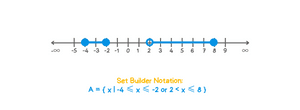
Solution
From the above number line, the values of x are described as “ values of x are the real numbers greater than -4 and equal to -2 or real numbers greater than 2 and equal to 8.
Set builder notation:
The set builder notation is given as
A = { x | -4 ≤ x ≤ -2 or 2 < x ≤ 8 }
Interval notation:
the interval notation is given as
A = [ -4 , -2 ] U ( 2 , 8 ]
Therefore, set builder notation is a method of writing sets often with an infinite number of elements. It is commonly used with rational numbers, real numbers, complex numbers, natural numbers, and many more. This notation can also be used to express sets with intervals and equations.
To further strengthen our concept of the set builder notation, consider the following practice problems.
Practice Problems
1.Write down the set builder notation of the following:
- { 1.1, 2.2, 3.3, 4.4, 5.5 }
- { a, e, i, o, u }
- { 2, 4, 6, 8, … }
- { 1, 3, 5, 7 }
- {violet, indigo, blue, green, yellow, orange, red}
2. Select the correct option.
a)Which of the following set is equal to the given set below?
A = { x € r | -7 < x < 3 }
- { -4, -3, -2, -6 }
- { -7, -6, -5, -4, -3, -2, -1, 0, 1, 2, 3 }
- { -7, -5, -3, -1, 1, 2, 3 }
b)Which of the following accurately explains the meaning of the given set below?
B = { x | x is even number }
- The set containing all the values of x such that x is an odd number.
- The set containing all the values of x such that x is a real number.
- The set containing all the values of x such that x is an even number.
c)What does this mean | in set builder notation?
- Belongs to
- Such that
- None of them
3. Write the following in the roster form
- B = { x € I |, -3 < x < 3)
- D = { x € R | -4 < x < 5 }
- O = { {x : x € W, x ≤ 5}
4. Are the following pairs of sets equal?
- A = {2} B = {x : x ∈ N, x is an even prime number}.
- P = {1, 4, 9} Q = {x : x = n2, n ∈ N, n ≤ 3)
5. Graph the interval and then express using set-builder notation.
Interval: (∞ , 9]
Answers
1.
- { x € R | 1 < x < 6 }
- { x | x is a vowel in English alphabet }
- { x | x is an even number }
- { x € O | 1 ≤ x ≤ 7 }
- {x | x is color of rainbow }
2.
- (2)
- (3)
- (2)
3.
- { -3, -2, -1, 0, 1, 2, 3 }
- { -3, -2, -1, 0, 1, 2, 3, 4 }
- { 0, 1, 2, 3, 4, 5 }
4.
- yes.
- yes.
5.
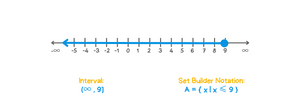
Therefore, the set builder notation is given as
A = { x | x ≤ 9 }
The set contains all the numbers equal to or less than 9.
